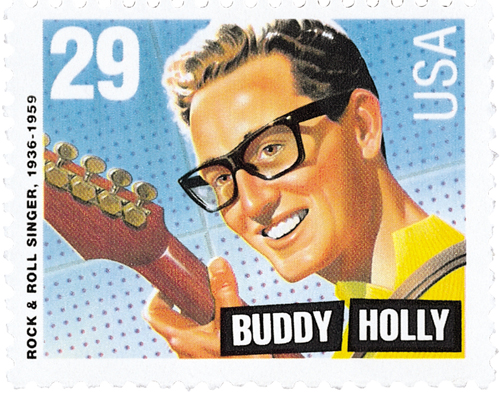
# 4900839 - 1993 Rock 'n' Roll Buddy Holly Combo PFCD
Often called the ultimate philatelic issue, the Fleetwood Proofcard is a distinctive commemorative with an elegantly embossed surface. Each Proofcard bears an original work of art complementing the theme of the stamp and created exclusively for Fleetwood by a leading American artist. Proofcards are often collected on their own, but would also make a beautiful addition to your existing stamp or cover collection.
Birth Of Buddy Holly
The fourth and youngest child in his family, Holly’s mother called him “Buddy” from an early age. He learned to play piano, fiddle, and guitar very young and his parents supported his musical ambitions.
| Click any of these images to order additional conditions and covers for your collection. |
Holly was initially influenced by the likes of Jimmie Rodgers and the Carter Family and had his beginnings as a country artist. After high school, Holly created a country western band and frequently had his songs played on the local radio station. Playing in small clubs in the Southwest, he gained a local following and was soon signed on by Decca records as a country singer.

During this time, Holly’s band often opened for larger national acts. Among them was Elvis Presley in 1955. After opening for Presley, Holly was enamored with the singer and emulated his musical style. Soon his band started playing rock ‘n’ roll.

Deciding he had greater potential as a rock artist, Decca had him record both solo and as the lead singer of a group called the Crickets. Both ventures proved to be extremely successful. In 1957 his song “Peggy Sue” hit the charts and the Crickets’ “That’ll Be the Day” sold over a million copies.
Often called the ultimate philatelic issue, the Fleetwood Proofcard is a distinctive commemorative with an elegantly embossed surface. Each Proofcard bears an original work of art complementing the theme of the stamp and created exclusively for Fleetwood by a leading American artist. Proofcards are often collected on their own, but would also make a beautiful addition to your existing stamp or cover collection.
Birth Of Buddy Holly
The fourth and youngest child in his family, Holly’s mother called him “Buddy” from an early age. He learned to play piano, fiddle, and guitar very young and his parents supported his musical ambitions.
| Click any of these images to order additional conditions and covers for your collection. |
Holly was initially influenced by the likes of Jimmie Rodgers and the Carter Family and had his beginnings as a country artist. After high school, Holly created a country western band and frequently had his songs played on the local radio station. Playing in small clubs in the Southwest, he gained a local following and was soon signed on by Decca records as a country singer.

During this time, Holly’s band often opened for larger national acts. Among them was Elvis Presley in 1955. After opening for Presley, Holly was enamored with the singer and emulated his musical style. Soon his band started playing rock ‘n’ roll.

Deciding he had greater potential as a rock artist, Decca had him record both solo and as the lead singer of a group called the Crickets. Both ventures proved to be extremely successful. In 1957 his song “Peggy Sue” hit the charts and the Crickets’ “That’ll Be the Day” sold over a million copies.














